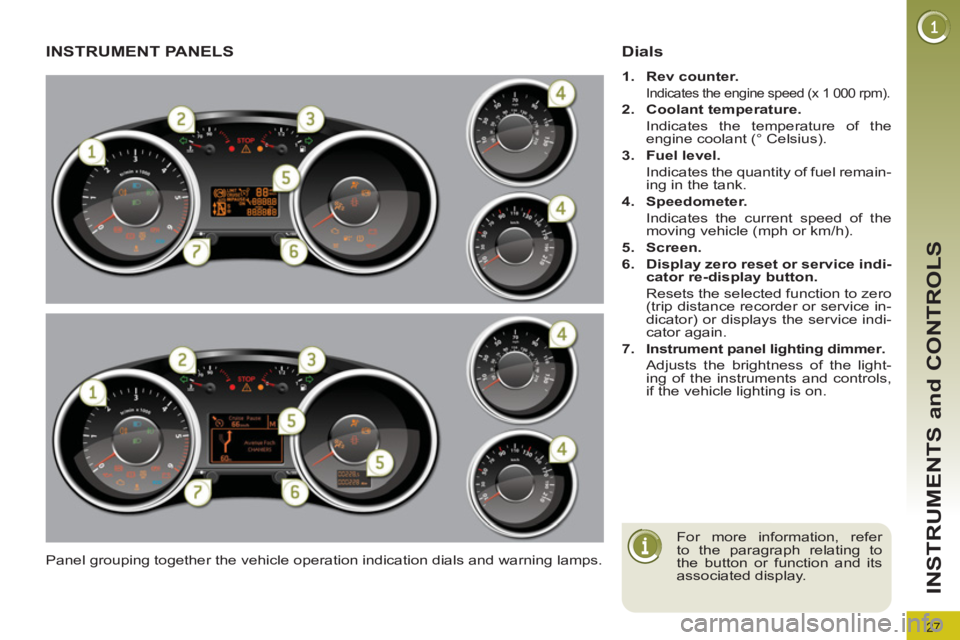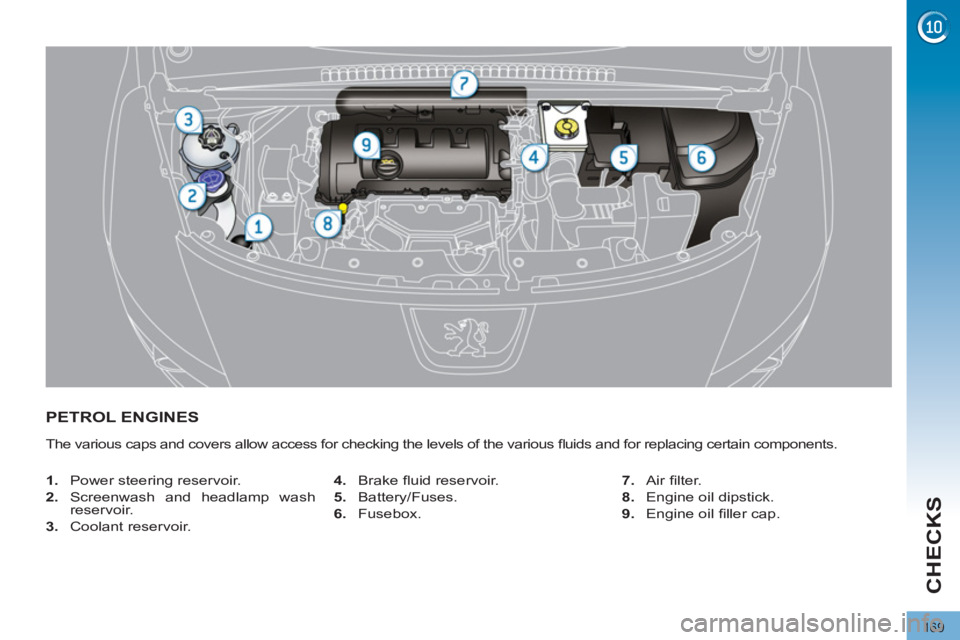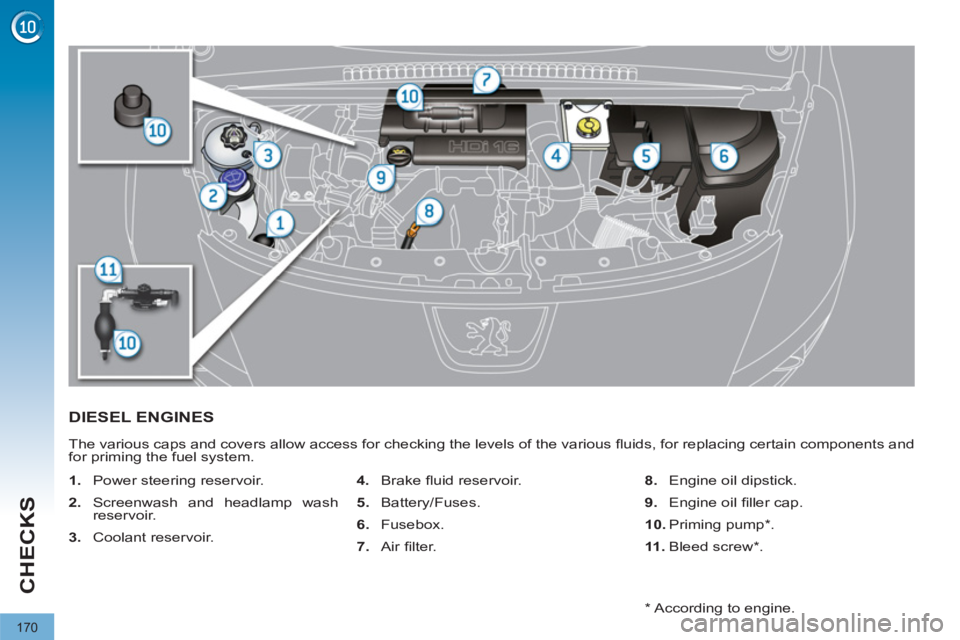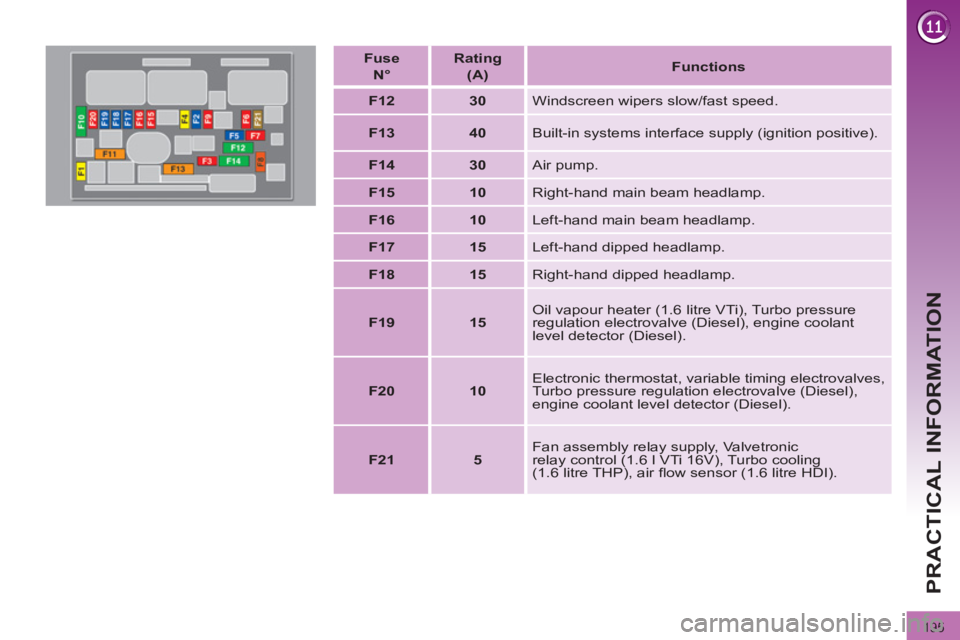2011 PEUGEOT 308 engine coolant
[x] Cancel search: engine coolantPage 29 of 328

27
INSTRUMENTS and CONTROLS
INSTRUMENT PANELS
Panel grouping together the vehicle operation indication dials and warning lamps.
Dials
1.
Rev counter.
Indicates the engine speed (x 1 000 rpm).
2.
Coolant temperature.
Indicates the temperature of the
engine coolant (° Celsius).
3.
Fuel level.
Indicates the quantity of fuel remain-
ing in the tank.
4.
Speedometer.
Indicates the current speed of the
moving vehicle (mph or km/h).
5.
Screen.
6.
Display zero reset or service indi-
cator re-display button.
Resets the selected function to zero
(trip distance recorder or service in-
dicator) or displays the service indi-
cator again.
7.
Instrument panel lighting
dimmer
.
Adjusts the brightness of the light-
ing of the instruments and controls,
if the vehicle lighting is on.
For more information, refer
to the paragraph relating to
the button or function and its
associated display.
Page 37 of 328

35
INSTRUMENTS and CONTROLS
Warning lamp
is on
Cause
Action/Observations
Engine
autodiagnosis
system
fi xed. The emission control system
has a fault. The warning lamp should go off when
the engine is started.
If it does not go off, contact a PEUGEOT
dealer or qualifi ed workshop without delay.
fl ashing. The engine management
system has a fault.
Risk of destruction of the catalytic converter.
Have it checked by a PEUGEOT dealer or a
qualifi ed workshop.
Low fuel
level
fi xed with the needle
in the red zone. When it fi rst comes on there
remains approximately
6 litres
of fuel in the tank.
At this point, you begin to
use the fuel reserve.
Refuel as soon as possible to avoid running out of fuel.
This warning lamp will come on every time the ignition
is switched on, until a suffi cient addition of fuel is made.
Fuel tank capacity: approximately 60 litres
.
Never continue to drive until you run out of fuel, as
this could damage the emission control and injection
systems.
Maximum
coolant
temperature
fi xed with the needle
in the red zone. The temperature of the
cooling system is too high. Stop as soon as it is safe to do so.
Wait until the engine has cooled down
before topping up the level, if necessary.
If the problem persists, contact a PEUGEOT
dealer or a qualifi ed workshop.
Engine oil
pressure
fi xed. There is a fault with the
engine lubrication system. You must stop as soon it is safe to do so.
Park, switch off the ignition and contact a
PEUGEOT dealer or a qualifi ed workshop.
Dynamic
stability
control
(ESP/ASR)
fl ashing. The ESP/ASR regulation is
active. The system optimises traction and
improves the directional stability of the
vehicle.
fi xed. Unless it has been
deactivated (button pressed
and its indicator lamp on) the
ESP/ASR system has a fault. Have it checked by a PEUGEOT or a
qualifi ed workshop.
Page 39 of 328

37
INSTRUMENTS and CONTROLS
Coolant temperature indicator
With the engine running, when the nee-
dle is:
- in zone A
, the temperature is correct,
- in zone B
, the temperature is too
high; the max temperature warning
lamp 1
and the central STOP
warn-
ing lamp come on, accompanied by
an audible signal and a message in
the screen. After driving for a few minutes, the tem-
perature and pressure in the cooling
system increase.
To top up the level:
�)
wait for the engine to cool,
�)
unscrew the cap by two turns to al-
low the pressure to drop,
�)
when the pressure has dropped, re-
move the cap,
�)
top up the level to the "MAX" mark.
You must stop as soon as it is safe
to do so.
Wait a few minutes before switching off
the engine.
Contact a PEUGEOT dealer or a quali-
fi ed workshop.
Warning lamp
is on
Cause
Action/Observations
Directional
headlamps
fl ashing. The directional headlamps
system has a fault. Have it checked by a PEUGEOT dealer
or a qualifi ed workshop.
Under-
infl ated tyre
fi xed. The pressure in one or more
wheels is too low. Check the pressure of the tyres as soon
as possible.
This check should preferably be carried
out when the tyres are cold.
Page 171 of 328

169
CHECKS
PETROL ENGINES
The various caps and covers allow access for checking the levels of the various fl uids and for replacing certain components.
1.
Power steering reservoir.
2.
Screenwash and headlamp wash
reservoir.
3.
Coolant reservoir.
4.
Brake fl uid reservoir.
5.
Battery/Fuses.
6.
Fusebox.
7.
Air fi lter.
8.
Engine oil dipstick.
9.
Engine oil fi ller cap.
Page 172 of 328

170
CHECKS
DIESEL ENGINES
The various caps and covers allow access for checking the levels of the various fl uids, for replacing certain components and
for priming the fuel system.
1.
Power steering reservoir.
2.
Screenwash and headlamp wash
reservoir.
3.
Coolant reservoir.
4.
Brake fl uid reservoir.
5.
Battery/Fuses.
6.
Fusebox.
7.
Air fi lter.
8.
Engine oil dipstick.
9.
Engine oil fi ller cap.
10.
Priming pump * .
11 .
Bleed screw * .
* According to engine.
Page 173 of 328

171
CHECKS
CHECKING LEVELS
Check all of these levels regularly and
top them up if necessary, unless other-
wise indicated.
If a level drops signifi cantly, have the
corresponding system checked by a
PEUGEOT dealer or a qualifi ed work-
shop.
Brake fluid level
When the engine is warm, the tempera-
ture of the coolant is regulated by the fan.
This can operate with the ignition off.
On vehicles which are fi tted with a
particle emission fi lter, the fan may
operate after the vehicle has been
switched off, even if the engine is
cold.
In addition, as the cooling system is
pressurised, wait at least one hour after
switching off the engine before carrying
out any work.
To avoid any risk of scalding, unscrew
the cap by two turns to allow the pres-
sure to drop. When the pressure has
dropped, remove the cap and top up
the level.
Oil level
The check is carried out either when
the ignition is switched on using the
oil level indicator on the instrument
panel, or using the dipstick.
This manual check will only be correct if the
vehicle is on level ground and the engine
has been off for more than 30 minutes.
After topping up the oil, the check when
switching on the ignition with the oil level
indicator in the instrument panel will only
be valid 30 minutes after topping up. The brake fl uid level should be
close to the "MAX" mark. If it is
not, check the brake pad wear.
Changing the fl uid
Refer to the servicing booklet for details
of the interval for this operation.
Power steering fluid level
The power steering fl uid level
should be close to the "MAX"
mark. Unscrew the cap, with the
engine cold, to check the level.
Screenwash and headlamp
wash fluid
In the case of vehicles fi tted
with headlamp washers, the
low fl uid level is indicated by an
audible signal and a message
in the instrument panel screen.
Top up the reservoir when you stop the
vehicle.
Engine oil change
Refer to the servicing booklet for details
of the interval for this operation.
Oil specifi cation
The oil must be the correct grade for
your engine and conform to the manu-
facturer's recommendations.
Fluid specifi cation
The brake fl uid must conform to the
manufacturer's recommendations and
meet the DOT4 standard.
Changing the coolant
The coolant does not have to be
changed.
Fluid specifi cation
For optimum cleaning and to avoid
freezing, this fl uid must not be topped
up with or replaced with plain water.
Coolant level
The coolant level should be
close to the "MAX" mark but
should never exceed it.
Fluid specifi cation
The coolant must conform to the manu-
facturer's recommendations.
When working under the bon-
net, take care, as certain areas
of the engine may be extreme-
ly hot (risk of burns).
It is normal to top up the oil level
between services. PEUGEOT
recommends that you check
the oil level and top up if necessary ev-
ery 3 000 miles (5 000 kilometres). In order to maintain the reliability of the
engine and emission control system,
the use of additives in the engine oil is
prohibited.
Page 196 of 328

194
PRACTICAL INFORMATION
Engine compartment fuses
The fusebox is placed in the engine
compartment near the battery (left-hand
side).
Access to the fuses
�)
Unclip the cover.
�)
Change the fuse (see corresponding
paragraph).
�)
When you have fi nished, close the
cover carefully to ensure correct
sealing of the fusebox.
Fuse table
Fuse
N°
Rating
(A)
Functions
F1
20
Engine control unit supply, injection pump and EGR
electrovalves (2 litre HDI), injectors (2 litre HDI).
F2
15
Horn.
F3
10
Front/rear wash-wipe.
F4
10
Daytime running lamps.
F5
15
Purge canister, turbine discharge and Turbo
pressure regulation electrovalves (1.6 litre THP),
oil vapour heater (1.6 litre THP), diesel heater
(1.6 litre HDI).
F6
10
Diagnostic socket, directional headlamps, particle
emission fi lter pump (Diesel), Distance alert,
engine coolant level detector, mirror adjustment
control.
F7
10
Power steering control unit, automatic gearbox,
directional headlamps height adjustment motor.
F8
20
Starter motor control.
F9
10
Clutch and brake pedal switches.
F10
30
Engine control unit actuators (petrol: ignition
coils, electrovalves, oxygen sensors, injectors,
heaters, fuel pump, electronic thermostat)
(Diesel: electrovalves, heaters).
F11
40
Air conditioning fan.
Page 197 of 328

195
PRACTICAL INFORMATION
Fuse
N°
Rating
(A)
Functions
F12
30
Windscreen wipers slow/fast speed.
F13
40
Built-in systems interface supply (ignition positive).
F14
30
Air pump.
F15
10
Right-hand main beam headlamp.
F16
10
Left-hand main beam headlamp.
F17
15
Left-hand dipped headlamp.
F18
15
Right-hand dipped headlamp.
F19
15
Oil vapour heater (1.6 litre VTi), Turbo pressure
regulation electrovalve (Diesel), engine coolant
level detector (Diesel).
F20
10
Electronic thermostat, variable timing electrovalves,
Turbo pressure regulation electrovalve (Diesel),
engine coolant level detector (Diesel).
F21
5
Fan assembly relay supply, Valvetronic
relay control (1.6 l VTi 16V), Turbo cooling
(1.6 litre THP), air fl ow sensor (1.6 litre HDI).